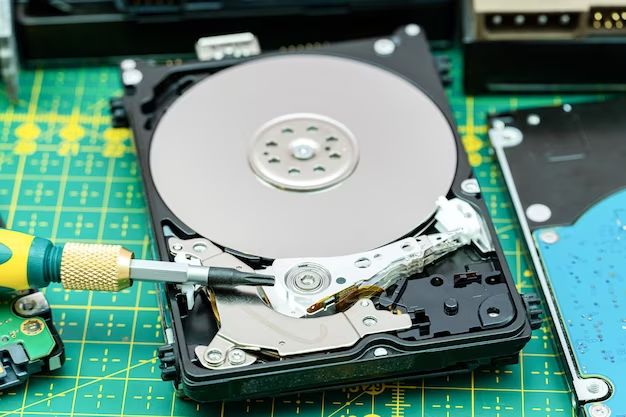If you notice your hard drive making rattling or clicking noises, it could be a sign of a serious issue. In this article, we’ll explore some of the common causes of a rattling hard drive and what you can do about it.
What’s Causing the Noise?
There are a few main components in a hard drive that can make noise when they fail:
- Read/write heads – These are small electromagnetic coils that move back and forth over the drive platters to read and write data. If they become misaligned or damaged, they can vibrate against the platters.
- Spindle motor – This small electric motor spins the platters at high speeds. If it develops problems with its ball bearings, it may make rattling noises.
- Actuator arm – This arm swings the read/write heads into position. If its bearings get worn out, it can cause knocking or grinding noises.
So in most cases, rattling noises point to a mechanical failure in one of these components. The rapid movements required in hard drives mean there are many small parts that can wear out over time.
Main Causes of a Rattling Hard Drive
Here are some of the most common specific causes of a rattling hard drive:
Worn Read/Write Heads
The read/write heads float microscopically close to the platters inside the drive. After thousands of hours of use, the heads can wear down and then start vibrating against the platters when they move. This creates a distinctive rattling noise during drive operation.
Damaged or Sticking Actuator Arm
The actuator arm swings back and forth rapidly to move the heads over the platters. Problems like worn bearings or screwed up alignment can cause this arm to get stuck and hit internal components, making knocking or grinding noises.
Failing Spindle Motor
A worn out spindle motor with bad ball bearings can emit rattling noises as the platters spin at 5,400-10,000 RPM. The noise usually gets worse over time as the motor further deteriorates.
Loose Internal Parts
If any small components like screws or washers come loose inside the hard drive housing, they can rattle around and create noise. This most commonly happens due to physical impacts like dropping the drive.
Desiccation
Desiccation refers to the lubricating oils inside the drive evaporating over time. This can cause metal parts like the actuator arm bushings to grind and knock against each other.
When to Worry About Hard Drive Noises
Hearing occasional new sounds from your hard drive is usually nothing to be concerned about. But here are some instances when you should worry about rattling or clicking noises:
- The noises get progressively louder or more frequent over days/weeks
- The noises happen during drive operation and aren’t just from drive startup/shutdown
- You notice degraded drive performance like slow access times, freezing, or crashes
- The rattling occurs when the drive is just sitting idle and not actively reading/writing
In these cases, the noises likely indicate a mechanical component is failing or there is internal damage. It’s a good idea to backup your data and consider replacing the drive.
Short-Term Fixes
If the rattling isn’t constant, here are some tips that may provide temporary relief and let you keep using the drive a bit longer:
- Open the drive housing and check for any loose internal parts that may be rattling around
- Turn off any antivirus software, which can sometimes cause drive access conflicts that produce noise
- Use a rubber grommet to mount the drive, isolating it from case vibration
- Place the drive on soft foam to reduce transferred vibrations
Note these are just stopgap measures and won’t fix any underlying mechanical issues. If the noises persist, it’s better to replace the drive.
Replacing a Failing Drive
If you have critical data on the rattling drive, the first step is to backup your files before the drive completely dies. Then you have a few options:
- Buy an identical replacement drive and swap it into your computer
- Upgrade to a new drive with higher capacity and performance
- Switch to an SSD for much faster access and silence
Here’s a quick table comparing the merits of each approach:
| Replacement Option | Pros | Cons |
|---|---|---|
| Identical drive | Least expensive Easy swap |
Same potential for failure No improvements |
| Higher capacity drive | More storage Faster than old drive |
Higher cost than identical replacement |
| SSD | Much faster access More reliable Silent |
Higher cost Lower capacities available |
If you decide to upgrade your drive, be sure to check compatibility. For example, newer drives may require UEFI instead of BIOS or a different drive interface like SATA III vs. SATA II. Do your homework first!
Preventing Hard Drive Noise
To help minimize rattling issues in the future:
- Handle drives gently and limit physical shocks
- Keep your system and drives free of dust buildup
- Make sure drives are securely mounted in the case
- Don’t move your system while drives are powered on
With proper care and maintenance, today’s hard drives can last for many years without any noticeable noises or degradation in performance. But inevitably, the mechanical nature of hard drives means they will eventually fail.
Conclusion
If your hard drive starts rattling, try to identify the specific internal cause and take action before complete failure occurs. The noise likely means certain components are wearing out after prolonged use. With some luck, short-term fixes like drive mounting adjustments may temporarily resolve the issue. But more often, the only true solution is to backup your data and replace the aging drive. To avoid problems in the first place, be extremely careful when handling drives and only swap them with your system powered down.
